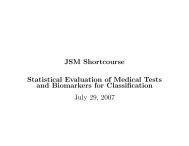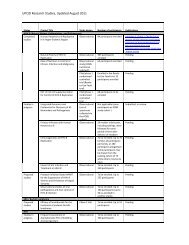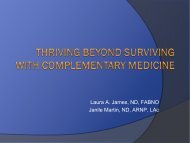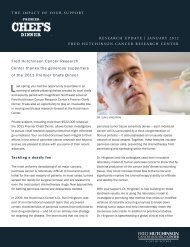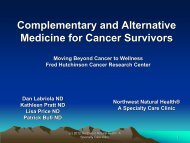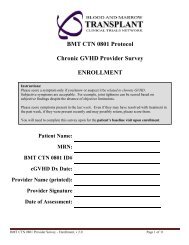Summer Undergraduate Research Program - Fred Hutchinson ...
Summer Undergraduate Research Program - Fred Hutchinson ...
Summer Undergraduate Research Program - Fred Hutchinson ...
You also want an ePaper? Increase the reach of your titles
YUMPU automatically turns print PDFs into web optimized ePapers that Google loves.
Cloning of HIV-1 env genes from Kenyan women to examine role of neutralizing antibodies<br />
in breast milk mother-to-child transmission<br />
Amber Peden, Jennifer Maroa, Julie Overbaugh<br />
<strong>Fred</strong> <strong>Hutchinson</strong> Cancer <strong>Research</strong> Center, Seattle, WA<br />
Abstract Methodology Results<br />
controls<br />
patient env<br />
2010 Lee Hartwell Poster Award<br />
Figure 7. PCR product of donor env.<br />
Study Cohort: The subjects were from a randomized breastfeeding clinical trial<br />
conducted between 1992-1998 in Nairobi, Kenya. HIV-1 infected women were<br />
enrolled in the clinical trial at 32 weeks gestation. BM and peripheral blood samples<br />
were collected from women at set time points for up to two years. Sixteen women<br />
with an early BM sample were selected for the initial screen of BM Nabs.<br />
patient env controls<br />
Figure 8. Donor env after gel<br />
isolation and PCR purification.<br />
HIV-1 env cloning<br />
Figure 3. HIV-1 genome. The env<br />
gene, codes for vital HIV-1 coat<br />
proteins crucial in mediating CD4<br />
and chemokine receptor binding<br />
and membrane fusion.<br />
Mother-to-child transmission (MTCT) of human immunodeficiency virus type-1 (HIV-1)<br />
can occur in utero, during delivery and during breastfeeding (BF). In resource-limited<br />
countries BF continues to be the preferred mode of infant feeding resulting in, more<br />
than one-third of MTCT cases. Interestingly, two thirds of the infants remain uninfected<br />
despite continued exposure to the virus. The mechanism by which these infants are<br />
protected remains unclear. Neutralizing antibodies (Nabs) act by blocking the initial<br />
virus-target cell interaction and therefore are of great interest to researchers in an effort<br />
to develop an effective HIV vaccine. Although antibodies have been detected in breast<br />
milk (BM) there has been no detailed study that examines the presence and correlation<br />
of levels of Nabs in breast milk with rate of BM transmission. To examine the role of<br />
Nabs, we attempted to clone HIV-1 env genes from HIV-1 seropositive mothers in a<br />
breastfeeding clinical trial in Nairobi, Kenya with the prospect of examining their<br />
neutralization sensitivities in an in vitro neutralization assay.<br />
cut a uncut a cut b<br />
Figure 9. Screening of recombinant<br />
plasmid shows successful insertion<br />
of donor env.<br />
uncut b<br />
insert<br />
Background<br />
No insert<br />
We attempted amplification of env from three different individuals. The results shown<br />
above are from one individual which yielded a successful clone.<br />
Challenges<br />
Figure 1. Adults and<br />
children living with<br />
HIV. Approximately<br />
70% of people living<br />
with HIV reside in Subsaharan<br />
Africa<br />
(UNAIDS, 2008).<br />
153<br />
HIV portrays genetic diversity within and across clades, and also within individuals. This<br />
was the major hindrance of our DNA cloning. Mutations in the env gene of donor DNA<br />
caused primer mismatching, prohibiting proper amplification and restriction enzyme<br />
digestion thereafter.<br />
MTCT accounted for approximately 20% of new HIV infections in 2008 and<br />
accounts for approximately 1,200 new child infections everyday (UNAIDS,<br />
2008).<br />
Figure 4. Cloning patient env genes. Nested PCR of patient DNA using specific primers allows for selective<br />
amplification of env. Once multiple copies are produced, DNA is digested with restriction enzymes that<br />
produce fragments with sticky ends. Plasmid DNA and donor DNA is then mixed and ligated with DNA ligase<br />
to yield recombinant plasmid. Recombinant molecules are replicated in E.coli to give a population of clones<br />
that are used to create pseudoviruses.<br />
Figure 10. DNA sequences of donor, PCR primers and env region of full-length HIV-1.<br />
Shows comparison of DNA sequences between second round PCR primers and second<br />
round PCR product indicating a mismatch.<br />
Formula feeding has been successful in developed countries but its<br />
implementation in Sub-Saharan Africa has been met with several challenges –<br />
cultural, cost, safety and increase in child mortality.<br />
Antiretroviral drugs significantly reduce MTCT prevention however the benefit<br />
of short course interventions against BM transmission is minimal.<br />
Future Directions<br />
Figure 5. Making pseudoviruses. A mammalian cell line is transfected with our donor recombinant<br />
plasmid and a plasmid containing the HIV-1 backbone genetically void of env to produce a HIV-1<br />
pseudovirus.<br />
~60% of BF infants remain uninfected despite continued exposure to HIV.<br />
Investigating how BM protects infants from HIV infection requires an<br />
examination of its immune factors.<br />
Re-design DNA PCR primers.<br />
Generate more patient clones from different PCRs.<br />
Test functionality of inserts.<br />
Make pseudoviruses and perform neutralization assays.<br />
Nabs have the ability to block initial virus-target cell interactions and if present<br />
in BM, may potentially alter the risk of BF transmission.<br />
References<br />
env<br />
Kuhn, Louise, et al. "HIV prevention is not enough: child survival in the context of prevention of<br />
mother-to-child HIV transmission." Journal of the International AIDS society (2009).<br />
Funding Source:<br />
Continuing Umbrella of <strong>Research</strong> Experience CURE<br />
(3 P30 CA015704-36S2/5 P30 CA015704-35S)<br />
Second Contributor<br />
Walmart College Success Award<br />
Phogat, S., R. T. Wyatt and G. B. Karlsson Hedestam. "Inhibition of HIV-1 entry by antibodies:<br />
potential viral and cellular targets." Journal of Internal Medicine (2007): 26-43.<br />
Objective: To clone env<br />
genes from HIV-positive<br />
women which will be<br />
employed in in vitro assays<br />
to determine the presence<br />
and potency of Nabs in BM.<br />
UNAIDS. "2009 AIDS epidemic update." 2009.<br />
Figure 6. Neutralization assay using TZM-bl cells as targets. Psuedoviruses are incubated with the<br />
breastmilk sample of interest followed by addition of TZM-bl cells that have a beta-galatosidase reporter<br />
gene under control of HIV-1 LTR. Reporter gene expression was quantified by luminescence upon lysis and<br />
addition of substrate.<br />
Figure 2. Antibodies can block the virustarget-cell<br />
interaction.




